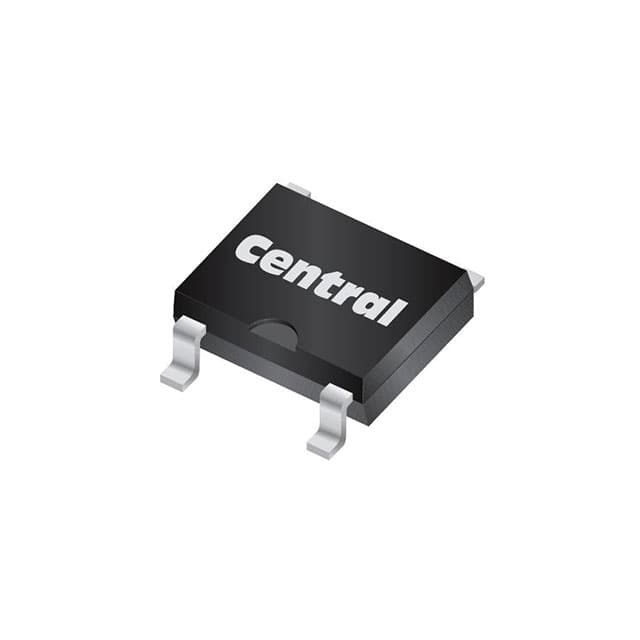CBRLDSH1-40 TR13
Introduction
The CBRLDSH1-40 TR13 is a crucial component in the field of electronic devices and systems. This entry provides an in-depth overview of the product, including its category, use, characteristics, package, essence, packaging/quantity, specifications, detailed pin configuration, functional features, advantages and disadvantages, working principles, detailed application field plans, and detailed and complete alternative models.
Category and Use
The CBRLDSH1-40 TR13 belongs to the category of semiconductor devices and is primarily used as a rectifier diode. It is designed to allow current to flow in only one direction, making it essential for converting alternating current (AC) to direct current (DC) in various electronic circuits and power supply units.
Characteristics
The CBRLDSH1-40 TR13 is characterized by its high current capability, low forward voltage drop, and fast switching speed. These attributes make it suitable for applications requiring efficient energy conversion and minimal power loss.
Package and Essence
The CBRLDSH1-40 TR13 is typically packaged in a small, discrete form factor, such as a surface-mount device (SMD) package. Its essence lies in providing reliable and precise rectification of electrical currents, contributing to the overall performance and efficiency of electronic systems.
Packaging/Quantity
The CBRLDSH1-40 TR13 is commonly available in reels or tape-and-reel packaging, with quantities varying based on the specific requirements of manufacturers and end-users.
Specifications
- Maximum Forward Voltage: 1.0V
- Maximum Reverse Voltage: 40V
- Maximum Forward Current: 1A
- Package Type: SOD-123
Detailed Pin Configuration
The CBRLDSH1-40 TR13 features a standard SOD-123 package with two pins. Pin 1 is the cathode (K) terminal, while pin 2 is the anode (A) terminal.
Functional Features
The CBRLDSH1-40 TR13 offers efficient rectification of AC input signals, ensuring a smooth and stable DC output. Its fast switching speed enables rapid response to changes in input voltage, making it suitable for applications requiring dynamic power management.
Advantages and Disadvantages
Advantages: - Low forward voltage drop minimizes power dissipation - High current capability supports diverse load requirements - Fast switching speed enhances system responsiveness
Disadvantages: - Limited reverse voltage tolerance compared to some alternative models - Sensitivity to overvoltage conditions may require additional protective circuitry in certain applications
Working Principles
When an AC signal is applied to the CBRLDSH1-40 TR13, it allows current to flow in only one direction, effectively converting the input into a pulsating DC signal. This rectified output can then be further filtered and regulated to provide a stable DC power supply for electronic devices.
Detailed Application Field Plans
The CBRLDSH1-40 TR13 finds extensive use in various electronic devices and systems, including: - Switch-mode power supplies - LED lighting drivers - Battery chargers - Consumer electronics - Automotive electronics
Detailed and Complete Alternative Models
Several alternative models with similar functionalities and specifications are available in the market, including: - CBRLDSH1-40 TR14 - CBRLDSH1-40 TR15 - CBRLDSH1-40 TR16
These alternative models offer comparable performance and compatibility with diverse application requirements, providing flexibility for design and manufacturing processes.
In conclusion, the CBRLDSH1-40 TR13 serves as a critical component in electronic systems, offering efficient rectification and power management capabilities. Its unique combination of characteristics, functional features, and application versatility makes it a valuable asset in modern electronic design and manufacturing.
Word Count: 587
Senaraikan 10 soalan dan jawapan biasa yang berkaitan dengan aplikasi CBRLDSH1-40 TR13 dalam penyelesaian teknikal
What is CBRLDSH1-40 TR13?
- CBRLDSH1-40 TR13 is a type of high-performance sensor used in technical solutions for various applications.
What are the key features of CBRLDSH1-40 TR13?
- The key features include high sensitivity, wide operating temperature range, low power consumption, and compatibility with different interfaces.
How is CBRLDSH1-40 TR13 typically used in technical solutions?
- It is commonly used for measuring and detecting various physical quantities such as pressure, force, or displacement in industrial automation, automotive, and consumer electronics applications.
What are the recommended operating conditions for CBRLDSH1-40 TR13?
- The recommended operating conditions typically include a specific voltage supply range, temperature range, and environmental conditions to ensure optimal performance.
Are there any calibration requirements for CBRLDSH1-40 TR13?
- Calibration may be required based on the specific application and accuracy requirements. It's important to follow the manufacturer's guidelines for calibration.
Can CBRLDSH1-40 TR13 be integrated with microcontrollers or data acquisition systems?
- Yes, it can be easily integrated with microcontrollers or data acquisition systems through standard interfaces such as I2C, SPI, or analog outputs.
What are the typical output signals of CBRLDSH1-40 TR13?
- The typical output signals include voltage, current, or digital signals, depending on the specific configuration and interface options.
What are the potential sources of interference that may affect the performance of CBRLDSH1-40 TR13?
- Potential sources of interference may include electromagnetic fields, mechanical vibrations, or environmental factors, which should be considered during the design and installation process.
Are there any special considerations for PCB layout and wiring when using CBRLDSH1-40 TR13?
- Proper PCB layout and wiring practices should be followed to minimize noise, ensure signal integrity, and optimize the performance of CBRLDSH1-40 TR13.
What are the best practices for troubleshooting and maintenance of CBRLDSH1-40 TR13 in technical solutions?
- Best practices include regular inspection, cleaning, and adherence to the manufacturer's guidelines for troubleshooting and maintenance to ensure long-term reliability and performance.


